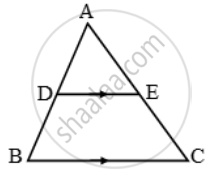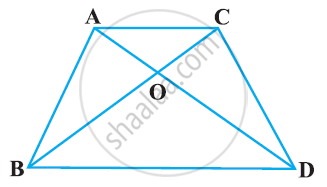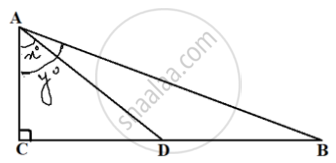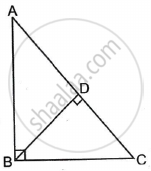Advertisements
Advertisements
Question
If ΔABC ~ ΔDEF such that AB = 5 cm, area (ΔABC) = 20 cm2 and area (ΔDEF) = 45 cm2, determine DE.
Solution
We have,
ΔABC ~ ΔDEF such that AB = 5 cm,
Area (ΔABC) = 20 cm2 and area(ΔDEF) = 45 cm2
By area of similar triangle theorem
`("Area"(triangleABC))/("Area"(triangleDEF))="AB"^2/"DE"^2`
`rArr20/45=5^2/"DE"^2`
`rArr4/9=5^2/"DE"^2`
`rArr2/3=5/"DE"` [Taking square root]
`rArr"DE"=(3xx5)/2=7.5` cm
APPEARS IN
RELATED QUESTIONS
Two isosceles triangles have equal vertical angles and their areas are in the ratio 16 : 25. Find the ratio of their corresponding heights
In the given figure, DE || BC and DE : BC = 3 : 5. Calculate the ratio of the areas of ∆ADE and the trapezium BCED

In Figure, ABC and DBC are two triangles on the same base BC. If AD intersects BC at O, show that `(ar(ABC))/(ar(DBC)) = (AO)/(DO)`

Prove that the area of an equilateral triangle described on one side of a square is equal to half the area of the equilateral triangle described on one of its diagonals
ABC is a triangle and PQ is a straight line meeting AB in P and AC in Q. If AP = 1 cm, PB = 3 cm, AQ = 1.5 cm, QC = 4.5 m, prove that area of ΔAPQ is one- sixteenth of the area of ABC.
Areas of two similar triangles are 225 sq.cm. 81 sq.cm. If a side of the smaller triangle is 12 cm, then Find corresponding side of the bigger triangle.
In the given figure, D is the mid-point of BC, then the value of `(coty^circ)/(cotx^circ)` is ______.

ΔABC ~ ΔPQR. In ΔABC, AB = 5.4 cm, BC = 4.2 cm, AC = 6.0 cm, AB:PQ = 3:2, then construct ΔABC and ΔPQR.
In the adjoining figure, ΔADB ∼ ΔBDC. Prove that BD2 = AD × DC.

If ΔABC ∼ ∆PQR and AB : PQ = 2 : 3, then find the value of `(A(triangleABC))/(A(trianglePQR))`.
